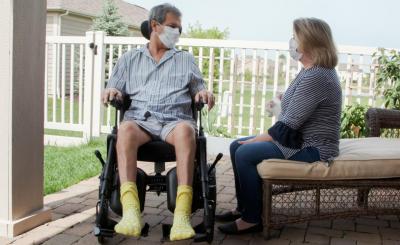
Mark and Brenda Zimmer spend time together at their Lewis Center, Ohio home. Mark was diagnosed with ALS two years ago and actively participates in clinical research to find effective treatments for the neurodegenerative disease. Image credit: The Ohio State Wexner Medical Center
Research led by investigators at The Ohio State University Wexner Medical Center provides new hope for recovery from degenerative neurological diseases — such as ALS and multiple sclerosis — as well from as damage caused by traumatic brain and spine injuries and stroke.
Using a mouse model, researchers at Ohio State and the University of Michigan discovered a new type of immune cell that not only rescues damaged nerve cells from death, but partially reverses nerve fiber damage. The research team also identified a human immune cell line, with similar characteristics, that promotes nervous system repair.
The next step is to harness this cell and expand it in a lab to enhance its healing effects. Researchers hope these cells can then be injected into patients to improve function and mobility and slow or stop progressive neurological decline.